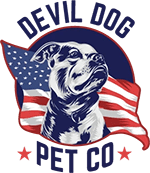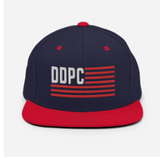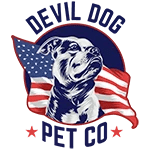Key Takeaways
- Your dog's memory is the foundation of training, bonding, and behavior management.
- Understanding dog memory distinguishes effective leaders from wishful thinkers.
- Dogs remember differently than humans, which impacts training and correction methods.
- Recognizing how your dog’s memory works is essential to connecting with your dog.
Table of Contents
- What Is Dog Memory?, Foundations Every Leader Must Know
- The Psychology of Dog Memory, How Dogs Encode, Store, and Recall Life
- Types of Dog Memory, Short-Term, Long-Term, Associative, and Episodic-Like
- Episodic-Like Memory, The Debate That Changes Training
- How Dogs Use Memory in Real Life, People, Places, Packs, and Problems
- Dog Memory vs. Human Memory, Key Differences Every Owner Should Know
- Senses on Patrol, How Dogs Use Smell, Hearing, and Sight to Trigger Memory
- Training for Stronger Memory, Actionable Techniques from the Devil Dog Playbook
- Dog Memory Challenges, Problems, Solutions, and How to Adapt
- Next-Level Enrichment, Games, Tools, and Chews for Sharper Dog Memory
- Living with Your Dog's Memory, How Leadership and Compassion Shape a Lifetime Bond
The Warrior's Guide to Dog Memory: Understanding, Training, and Honoring Your Dog's Mind
Your dog's memory isn't just trivia, it's the foundation of every training session, every bond you build, and every behavioral challenge you'll face. Understanding how dog memory works separates leaders from wishful thinkers. Dogs don't remember like humans, and that changes everything about how you train, correct, and connect with your four-legged battle buddy.
Memory shapes your dog's reality. When Dexter associates the sound of your boots with walk time, that's associative memory at work. When he remembers a traumatic vet visit months later, that's emotional encoding. Master these mechanisms, and you'll unlock training breakthroughs most owners never achieve.
What Is Dog Memory?, Foundations Every Leader Must Know
Dog memory is your pup's ability to encode, store, and retrieve experiences, but it operates fundamentally differently from human cognition. While humans excel at episodic memory (remembering specific events with context), dogs dominate associative memory, linking sensory triggers to emotional outcomes with laser precision.
The stakes matter because misunderstanding canine memory leads to failed training, behavioral issues, and frustrated owners. Dogs don't "hold grudges" or plot revenge, they respond to learned associations. That "guilty" look after chewing your shoe? Pure association between your angry tone and past corrections, not remorse.
| Memory Type | Dogs | Humans | Training Impact |
|---|---|---|---|
| Short-term | 2-5 minutes | 15-30 seconds active | Immediate rewards essential |
| Long-term | Years (with emotion) | Lifetime | Consistent patterns stick |
| Associative | Dominant strength | Secondary | Foundation of all training |
| Episodic | Limited/debated | Rich and detailed | Context matters less for dogs |
The Psychology of Dog Memory, How Dogs Encode, Store, and Recall Life

Inside your dog's brain, memory formation follows a battlefield-precise sequence: sensory input hits the hippocampus, emotional significance gets tagged by the amygdala, and repetition strengthens neural pathways. Unlike humans who can consciously choose to remember, dogs rely on emotional intensity and repetition to cement experiences.
Emotion acts as the memory's amplifier. Dexter's first thunderstorm creates a stronger memory than his hundredth meal because fear floods the brain with stress hormones that enhance encoding. This explains why traumatic experiences stick while routine commands fade without consistent reinforcement, making special moments like opening a Dog Birthday Box even more memorable.
The recall process activates when familiar triggers, scents, sounds, or sights, fire the same neural networks. This is why your dog remembers the vet's office smell months later, or why hearing a specific whistle can trigger perfect recall even after weeks of inconsistent practice.
Download the FREE 10-Step Dog Prep Guide
Types of Dog Memory, Short-Term, Long-Term, Associative, and Episodic-Like
Short-term memory in dogs lasts 2-5 minutes maximum, long enough to connect an action with immediate consequences, but useless for delayed corrections. This narrow window demands precision timing in training. Reward within seconds or lose the learning opportunity—using Safest Dog Chews as positive reinforcement can make those rewards both enjoyable and secure.
Long-term memory stores information indefinitely when reinforced by emotion or repetition. Dogs recognize owners after years of separation and remember traumatic events throughout their lives. Military working dogs demonstrate this by maintaining trained behaviors for years between deployments.
Associative memory dominates canine cognition, linking sensory experiences with emotional outcomes. The jingle of car keys means adventure, the vet's antiseptic smell means stress, the sound of kibble hitting the bowl means dinner. Master these associations and you control your dog's behavioral responses.
| Memory Type | Duration | Best Training Use | Example |
|---|---|---|---|
| Short-term | 2-5 minutes | Immediate corrections | Marking "No" during unwanted behavior |
| Long-term | Years | Command reliability | Recall training with consistent practice |
| Associative | Lifetime (with reinforcement) | Building habits | Leash = walk time |
| Episodic-like | Hours to weeks | Specific event recall | Remembering where a toy was hidden |
Episodic-Like Memory, The Debate That Changes Training
Whether dogs possess true episodic memory remains hotly debated among researchers, but the practical implications are clear. Dogs can recall specific events, Dexter remembering where he buried a bone last week, but lack the rich contextual detail humans experience. They remember "what" and "where" better than "when" or complex sequences.
| Memory Type | Definition | Example | Training Duration |
|---|---|---|---|
| Short-term | Working memory for immediate tasks | Following a complex command sequence | 2-5 minutes |
| Long-term | Permanent storage of habits and people | Recognizing family after deployment | Years to lifetime |
| Associative | Linking triggers to emotional outcomes | Car keys = walk time | 1-3 repetitions |
| Episodic-like | Recalling specific events with context | Remembering yesterday's park visit | Hours to weeks |
This memory structure explains why dogs excel at routine-based training but struggle with complex, multi-step commands without extensive conditioning. Build training around their associative strengths rather than fighting their cognitive limitations.
How Dogs Use Memory in Real Life, People, Places, Packs, and Problems

Dogs prioritize social memory above all else. They remember family hierarchies, individual scents, and behavioral patterns with remarkable precision. Dexter distinguishes between household members' footsteps and adjusts his behavior accordingly, that's sophisticated social memory in action.
Spatial memory helps dogs navigate territory and locate resources. They remember feeding spots, favorite sleeping areas, and escape routes. Military working dogs leverage this ability to clear buildings and navigate complex environments months after initial training.
Problem-solving memory allows dogs to remember what worked before. If digging under the fence succeeded once, they'll try again. If barking brought attention, they'll repeat the strategy. Understanding this pattern helps owners redirect unwanted behaviors before they become ingrained habits.
1. Identify the trigger (sound, location, person)
2. Create positive associations at a distance
3. Gradually decrease distance while maintaining positive outcomes
Dog Memory vs. Human Memory, Key Differences Every Owner Should Know
Dogs live in the present while humans dwell in past and future. This fundamental difference shapes every training interaction. Dogs don't ruminate over mistakes or plan revenge, they respond to immediate environmental cues based on past associations.
Human memory excels at abstract thinking and complex narratives. We remember why something happened and predict future outcomes. Dogs remember that something happened and how it felt. This emotional-first memory system makes consistency crucial, mixed messages create confusion, not learning.
| Aspect | Dog Memory | Human Memory | Leadership Implication |
|---|---|---|---|
| Time Focus | Present-moment | Past/future oriented | Immediate consequences only |
| Emotional Weight | Primary factor | Secondary factor | Feeling matters more than logic |
| Abstract Concepts | Limited | Advanced | Concrete rules work best |
| Narrative Memory | Minimal | Rich storytelling | Simple cause-effect training |
Senses on Patrol, How Dogs Use Smell, Hearing, and Sight to Trigger Memory
Scent dominates dog memory formation with 300 million olfactory receptors compared to humans' 6 million. A single whiff can transport your dog back to specific experiences, the vet's office, a favorite hiking trail, or a traumatic encounter. This makes scent-based training incredibly powerful when used strategically.
Auditory memory responds to tone, pitch, and rhythm more than specific words. Dogs remember the emotional content of your voice during training sessions. Consistent vocal patterns accelerate learning while erratic tones create confusion.
Visual memory focuses on movement patterns and body language rather than static details. Dogs remember how you move when angry versus happy, making your physical consistency as important as verbal commands.
• Hide treats in different rooms using scent trails
• Use specific whistle patterns for different commands
• Practice hand signals with consistent body positioning
Training for Stronger Memory, Actionable Techniques from the Devil Dog Playbook

Timing determines memory strength.
Reward within one second of correct behavior. This narrow window ensures your dog's memory links the action to the consequence. Miss it, and you're training confusion instead of clarity.
Start with three-minute sessions, twice daily. Short bursts prevent mental fatigue while building neural pathways. Dexter learned his recall command through consistent 180-second drills, no marathon sessions, just focused repetition.
Memory-Building Protocol
- Marker word: Use "Yes!" or click within 0.5 seconds of correct behavior
- High-value rewards: Reserve premium treats like yak chews for breakthrough moments
- Environmental rotation: Practice commands in 3-4 different locations weekly
- Spacing effect: Review learned commands every 48-72 hours to cement long-term retention
Environmental variety strengthens memory consolidation. Practice "sit" in the kitchen, backyard, and local park. Each new context forces your dog's brain to generalize the command rather than memorize location-specific cues.
Use natural chews as memory anchors. A split antler during crate training creates positive associations with confinement. The consistent texture and flavor become memory triggers that ease anxiety and reinforce good behavior patterns.
Dog Memory Challenges, Problems, Solutions, and How to Adapt
Fear-based memories stick like glue. One bad vet visit can create lasting anxiety that surfaces months later. The solution isn't avoidance, it's systematic counter-conditioning.
| Problem | Root Cause | Tactical Solution | Timeline |
|---|---|---|---|
| Command "forgetting" | Inconsistent reinforcement | Daily 3-minute review sessions | 2-3 weeks |
| Trauma recall | Single negative experience | Gradual exposure with high-value rewards | 4-8 weeks |
| Senior confusion | Cognitive decline | Simplified routines, familiar scents | Ongoing management |
| Puppy inconsistency | Developing neural pathways | Extra repetition, shorter sessions | 6-12 weeks |
Senior dogs need memory maintenance, not memory building. Stick to established routines and familiar commands. Introduce new concepts slowly, using scent markers and consistent verbal cues to support declining cognitive function.
Puppies aren't "forgetting", they're still building neural highways. What looks like memory failure is often incomplete learning. Double your repetitions and halve your expectations during the first six months.
Medical issues can scramble dog memory temporarily. Post-surgery confusion, medication side effects, and illness-related stress all impact recall. Work with your veterinarian to distinguish between medical and behavioral memory issues.
Next-Level Enrichment, Games, Tools, and Chews for Sharper Dog Memory
Mental stimulation builds memory muscle. Puzzle toys, scent games, and rotating challenges keep neural pathways active and engaged. Think of it as cross-training for your dog's brain.
Scent work activates the hippocampus, your dog's memory center. Hide treats around the house and use a consistent "find it" command. Start easy, increase difficulty weekly. This simple game strengthens both working memory and problem-solving skills.
Rotation Strategy: Switch enrichment tools every 5-7 days. Familiar items lose their cognitive challenge. Fresh puzzles and new chew textures maintain mental engagement and memory formation.
Natural chews serve double duty, dental health and cognitive stimulation. A whole elk antler provides hours of focused gnawing that reduces anxiety while exercising memory through repeated problem-solving attempts. The consistent reward keeps dogs engaged and mentally sharp.
Interactive feeding transforms mealtime into memory training. Slow-feeder bowls, snuffle mats, and treat-dispensing toys force dogs to remember successful strategies and adapt their approach. This daily cognitive exercise builds mental resilience.
Living with Your Dog's Memory, How Leadership and Compassion Shape a Lifetime Bond

Your dog's memory is a gift, and a responsibility. Every interaction becomes part of their permanent record. Harsh corrections create lasting fear; consistent leadership builds unshakeable trust.
Extreme Dog Leadership means showing up consistently, not perfectly. Your dog's memory forgives mistakes but remembers patterns. Be the leader who provides structure, safety, and unconditional commitment through every stage of life.
Marine Corps Wisdom: "Consistency under pressure builds trust that endures." The same principle applies to dog leadership. Your reliability in small moments creates the foundation for lifelong loyalty and obedience.
As Dexter aged, his memory became our shared history, every training session, every adventure, every quiet moment of connection. Honor your dog's memory by being worthy of their devotion. Lead with purpose, train with patience, and love without limits.
Download the FREE 10-Step Dog Prep Guide
Frequently Asked Questions
How long can a dog remember you?
Dogs can remember people for years, especially when strong emotional bonds or repeated positive interactions are involved. Their associative memory links your scent, voice, and appearance to feelings of safety and trust, allowing them to recognize and respond to you even after long absences.






